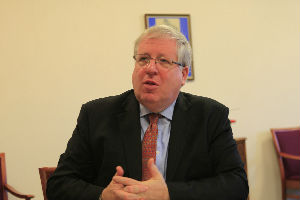Flag bearer for industrial revolution
Updated: 2013-10-25 12:57
By Chen Yingqun, Joseph Catanzaro and Song Wenwei (China Daily Africa)
|
|||||||||||
|
Nachi (Jiangsu) Industries Co Ltd is one of the high-tech companies that has been attracted to Zhangjiagang. Among other things, the company makes precision cutting tools, and industrial robots. Song Wenwei / China Daily |
It's out with the old and in with the new industries as Zhangjiagang looks beyond steel to new ways of doing business
China's largest private steel company, Shagang Group, plans to move away from steel as its primary business in as little as three years. The seismic shift being considered by the steel stalwart, unthinkable during the boom a decade ago, is the clearest indication to date of the mounting pressure traditional manufacturing sectors in China are facing to stay viable in a rapidly changing domestic and global market.
But in the city of Zhangjiagang in Jiangsu province, the base for Shagang's steel mill operations, some domestic and foreign companies see opportunity in the challenges besetting traditional industries.
They are the flag bearers of the so-called emerging industries, and they have begun to set up production facilities across the city.
Among those prepared to take a punt on what they perceive to be huge potential in the evolving Chinese market are German solar energy material manufacturer Krempel Group and Japanese machining and robot manufacturer Nachi Group, both of which set up operations in Zhangjiagang last year.
It is no coincidence that these companies chose to do business in the small but economically dynamic city on the Yangtze. Often held up as a success story of China's rapid industrialization and urbanization, Zhangjiagang has implemented a number of progressive development policies to attract investment from emerging industries.
Success, or failure, is likely to be viewed as a weathervane for other economic zones across the country.
"If we want to keep economic growth and also leave a beautiful city for generations to come, we have to transform the city and reduce our reliance on traditional industries and increase our innovation in emerging industries," says Yao Linrong, Party chief of Zhangjiagang.
"We need to develop an economy with low resources, low energy consumption, and low emissions."
While China maintains pride of place as the world's manufacturing hub, industrial transformation has been a strategic objective for the country in recent years as it seeks to mitigate expected cuts to employment and to government revenue that follow further decline in the profit margins of traditional sectors.
The old bastions of business are being encouraged to diversify, or at the very least to operate in a more fiscally sustainable fashion way. On October 15, the Government announced it would block new projects in a number of sectors suffering from overcapacity, including steel, aluminum, shipbuilding and cement.
Zhangjiagang, ranked in the top three of China's 100 county-level cities in terms of comprehensive competitiveness, needed little prompting to embark on a program of industrial reform.
Traditional businesses, such as printing and dyeing, have been moved out of the city's 120 square kilometers of prime industrial land and into less developed regions to make way for new projects.
Bigger companies in traditional industries have been encouraged to introduce new technology and diversify their brands, and companies that deal in cutting-edge technology, new energy and new materials have been courted and assisted in setting up shop.
Since 2010, the city has invested 54.3 billion yuan ($8.9 billion; 6.5 billion) in emerging industries, which accounts for more than 52 percent of Zhangjiagang's total industrial investment over that period.
The outlay is showing early dividends. In the past two years, revenue of companies in the emerging industries category has risen 30 percent a year.
Last year, the output value of emerging industries was 182.5 billion yuan, about 40 percent of the city's total industrial output. By 2015, it is expected to account for 50 percent.
Yao says traditional industries rode a boom driven by insatiable market demand after the country opened up in the 1980s. Between 2000 and 2008, Zhangjiagang's revenue rose from 1 billion yuan to 10 billion yuan.
But the days of easy money are now a thing of the past.
"The market has been saturated, and margins in traditional sectors have been affected for years by a massive supply glut, leaving many firms suffering heavy losses and reliant on government subsidies," Yao says. "Industrial transformation is urgently needed."
Shagang Group president Wang Xinghong revealed the steel giant is already preparing to diversify business, even though her company is still turning a tidy profit.
In the first half of this year, Shagang made a profit of 1 billion yuan and still employs about 20,000 of the city's 1.3 million residents.
But "occasional over production" and consistent "overcapacity" together with high raw material costs mean that while demand is still strong, profit margins are shrinking.
Today's Top News
British media figures in phone-hacking trial
Mythbuster dispels fictions about China
Forum urges stableChina-Japan ties
NSA spying hurts US diplomacy
Carrier rocket sent to launch base for moon landing
Requirements cut for business startups
Study shows PM1 most harmful
Cold snap to sweep NE, N China
Hot Topics
Lunar probe , China growth forecasts, Emission rules get tougher, China seen through 'colored lens', International board,
Editor's Picks

|

|

|

|

|

|






